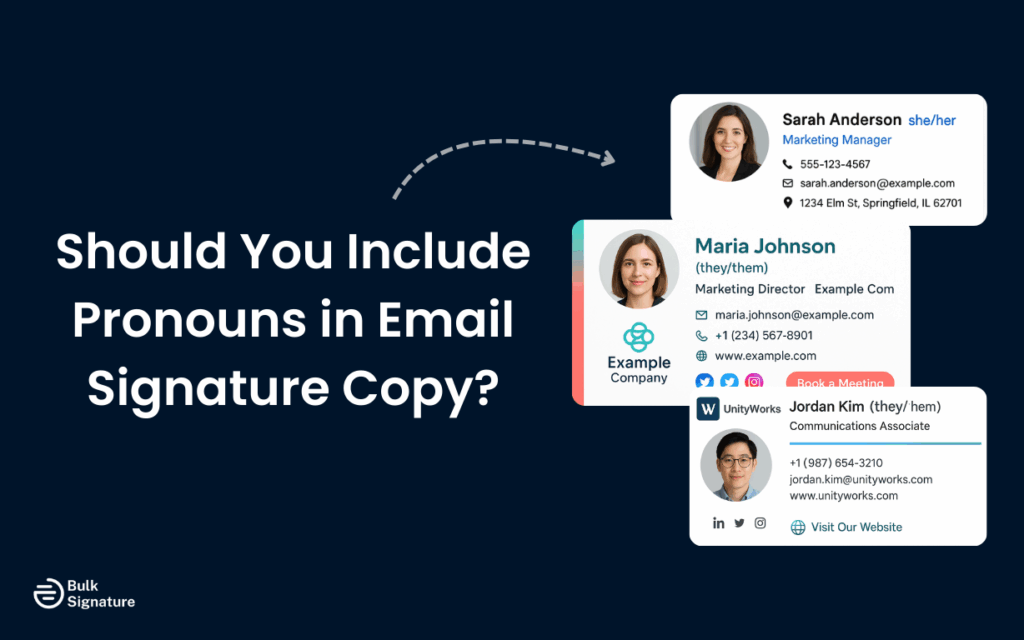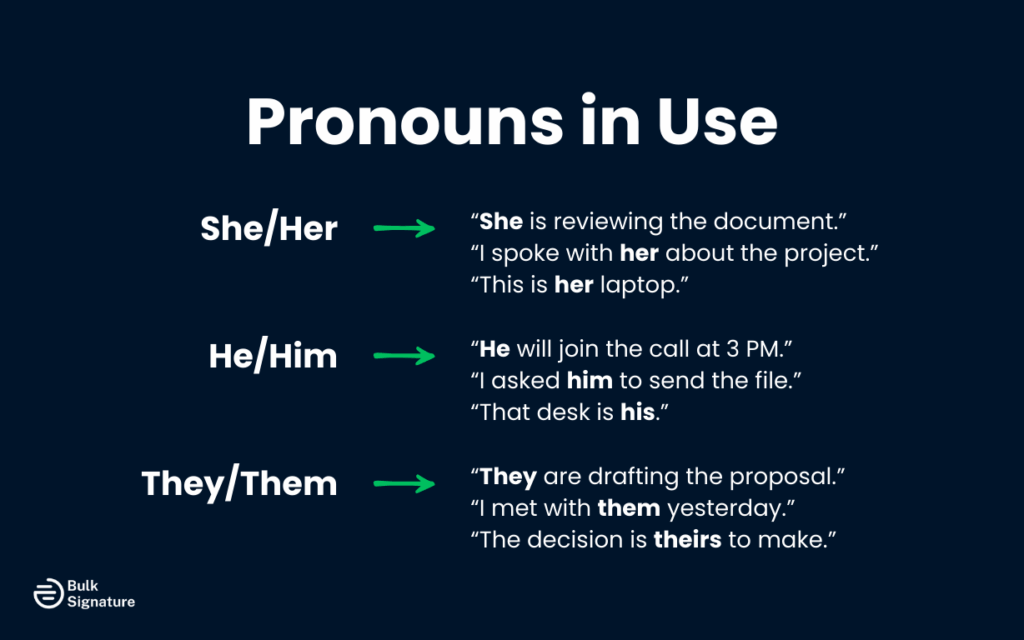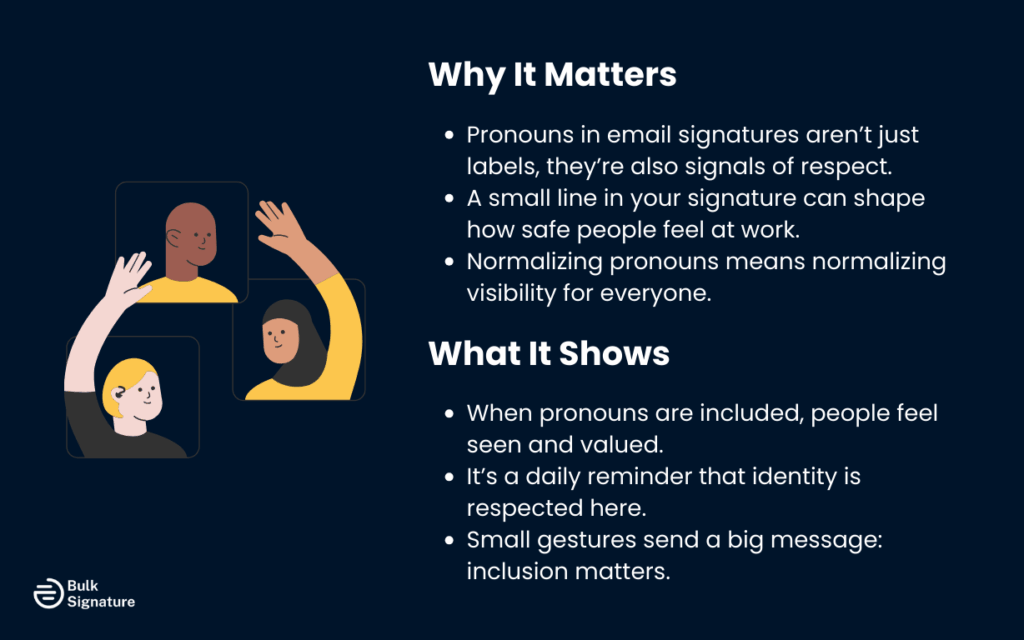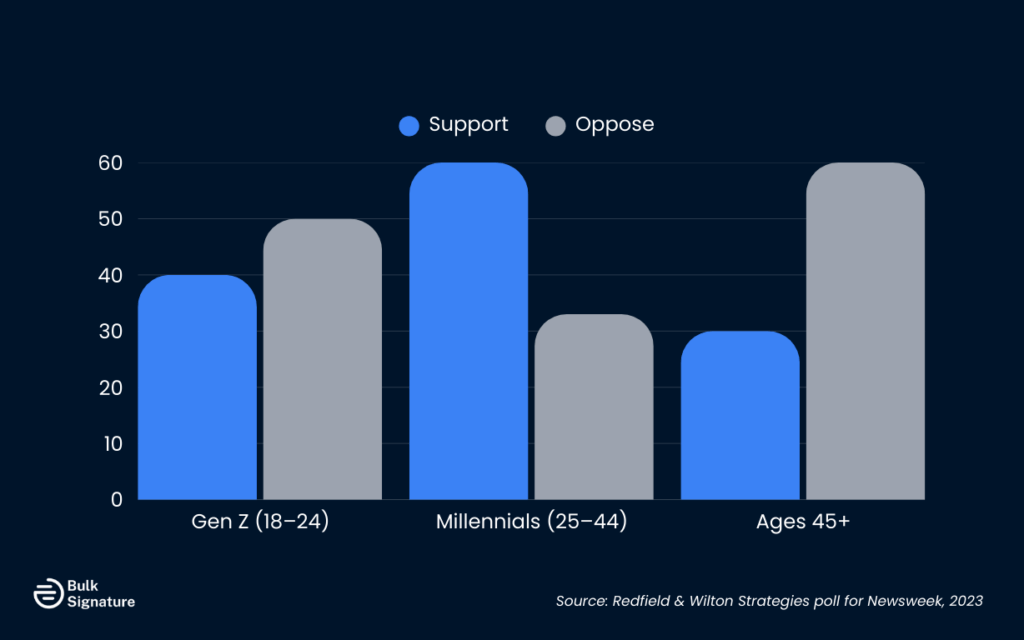
You’re sending a professional email with a clear message and polished tone. But what about the small line beneath your name? That quiet detail in your signature might carry more weight than you think.
As more companies embrace inclusive language in day-to-day communication, adding pronouns in email signatures has moved from a niche practice to a mainstream signal. It’s showing up in hiring emails, sales outreach, internal memos, and really anywhere identity and professionalism intersect.
According to a Harris Poll published by SAP, 73% of Americans believe employers should learn and use employees’ pronouns in the workplace. That belief is shaping how teams choose to present themselves in even the smallest brand touchpoints.
This article looks at what pronouns in email signatures mean, where the tension lies, and how your company can approach this choice with clarity, cultural awareness, and respect.
Why People Add Gender Pronouns to Their Signatures
Email signatures with pronouns clarify how someone wants to be addressed in conversation. This practice has evolved from academic and cultural institutions like university campuses and advocacy organizations into mainstream workplace communication. This shift has become more trendy as organizations across the world recognize the value of clear, respectful interaction.
The practice serves multiple purposes beyond the obvious function. It helps avoid confusion about a person’s gender, demonstrates respect for diverse identities, and shows support for colleagues who may not identify with traditional male or female categories assigned at birth.

Common Pronouns Used in Email Signatures
The most frequently seen gender pronouns in professional email signatures include she/her, he/him, and they/them. These pronouns tell recipients how a person identifies and would like to be addressed when referred to in email chains or meetings.
Gender neutral pronouns like they/them have gained significant acceptance in professional settings, particularly in cities like San Francisco and other progressive business hubs. Some individuals also use neo-pronouns like xe/xir or zie/zir. These, however, tend to be less frequently used in corporate environments.
The format typically appears as “they/them/theirs” or “they/them,” with theirs being used in the singular. In email signature examples, pronouns typically appear directly below the person’s name or alongside their job title.
A standard layout might read a couple of different ways. Here are some examples:
Jane Smith (she/her)”
John Doe, Marketing Manager | He/Him.
J.J. Johnson
Associate Producer
they/them/theirs
Gender neutral names present particular communication challenges in professional settings. When someone receives an email from Alex, Taylor, or Sam, gender neutral pronouns tell people the correct pronouns to use when addressing that person in future conversations.
Why Professionals Are Adding Pronouns to Email Chains
Professionals include pronouns in their signatures to create a more inclusive environment at their organization. When cisgender people list pronouns alongside colleagues who identify as non-binary or transgender, it takes the pressure off gender-diverse employees who are the only ones sharing this information.
Teams working across different cultures and languages particularly value this clarity. In fact, according to research from Bowling Green State University, workplaces that normalize sharing pronouns tend to foster stronger psychological safety, more inclusive environments for LGBTQ+ and gender-diverse co-workers, and higher overall job satisfaction.
Pronouns, Identity, and Inclusion: What's at Stake

The conversation around pronouns in email signatures touches on deeper questions about gender identity, workplace inclusion, and how organizations demonstrate their values through daily practices.
For many employees, seeing pronouns normalized in professional communication signals that their workplace recognizes and respects diverse identities beyond traditional male and female categories.
Pronouns Build Inclusive Workplaces
Adding pronouns in email signatures is a simple way to promote an inclusive environment and support gender identity in everyday workplace communication. When colleagues use a person’s correct pronouns, it affirms how that individual identifies and helps nonbinary and transgender employees feel respected and included.
This practice helps avoid confusion in professional communication, particularly in large organizations where people may not know each other well. The simple act shows support for respectful workplace interaction and signals that the organization values clear communication practices.
How Pronouns Reflect Company Culture
Including pronouns in email signatures signals how your organization values inclusive language, respect, and the employee experience. Internally, it reinforces that identity matters across all levels—beyond policy, through daily communication. Externally, it communicates your company’s commitment to inclusion and helps new hires or clients understand team culture from the start.
According to the Archives of Sexual Behavior, when companies consistently use a person’s correct name and pronouns, transgender employees feel significantly more included at work.
Small efforts like adding pronouns contribute to greater retention, psychological safety, and a more inclusive environment overall.
Pros of Including Pronouns in Email Signatures
According to a recent Harris Poll, 74% of Americans believe employers should learn and use employees’ pronouns, and 65% think employers should step in when they’re misused. Including pronouns can also generate leads by signaling alignment with values-driven customer sources.
Benefits of adding pronouns to email signatures include:
- Builds trust and respect by normalizing accurate, inclusive communication across teams and clients.
- Strengthens external credibility with clients and partners who value inclusive practices.
- Signals cultural alignment with DEI-minded customers—making it a subtle but effective brand differentiator.
- Promotes inclusivity without needing complex DEI policies or programs.
- Empowers employees to share their identity on their terms, reinforcing autonomy and belonging.
- Sets the tone for respectful communication across departments and hierarchies—especially when modeled by leadership.
Concerns, Controversies, and Pushback
While pronoun inclusion is gaining traction, some organizations face internal and external resistance based on industry norms, regional values, or stakeholder expectations.
Common concerns include:
- Cultural or political objections, especially in regions or industries where gender identity topics are considered sensitive or divisive.
- Privacy concerns from employees who feel pronoun sharing might expose personal information or pressure them to disclose aspects of their gender identity.
- Fear of backlash from clients, customers, or leadership teams who may view pronoun sharing as polarizing or unnecessary.
- Perception of compelled speech, where employees worry that mandatory pronoun sharing could infringe on personal or ideological boundaries.
- Reputation risk in conservative sectors, where inclusive practices may conflict with traditional norms or customer sentiment.
Generational Divide

Workplace attitudes around pronoun usage vary across age groups, and not always how you’d expect. A Redfield & Wilton Strategies poll (via Newsweek) found that millennials (ages 25–44) are more likely than Gen Z (18–24) to support requiring pronouns in work emails, with older generations showing even lower levels of support.
This challenges the common assumption that younger employees are universally more progressive. Millennials—many of whom now hold leadership roles—may view pronoun usage as part of professional standards, while Gen Z may lean more toward personal privacy.
The generational divide also shows up in how people approach self-disclosure. Some employees see pronouns as a way to express identity; others prefer to keep that information private.
Recognizing this nuance helps companies adopt inclusive practices that respect both visibility and choice.
Policy Pushback
Recent political developments have made pronoun policies more complex, especially in public sector environments. In early 2025, HR Grapevine reported that several U.S. government agencies were directed to remove pronouns from email signatures, signaling increased political scrutiny of gender-inclusive practices.
These shifts reflect broader tensions around identity and inclusion in the workplace. For private companies, the challenge lies in honoring their values and employee needs while staying aligned with evolving legal expectations.
As regulations change, flexibility becomes essential. One way to stay agile is by using a centralized email signature management system. This lets organizations adjust pronoun fields, update templates, or remove identifiers across teams quickly, without placing the burden on individual employees or risking inconsistency.
Working closely with legal counsel while using an adaptable communication infrastructure ensures your organization can remain inclusive while minimizing risk.
Best Practices for Adding Pronouns to Email Signatures
Including preferred pronouns in your email signature supports respectful, inclusive communication, especially for non-binary individuals and anyone whose identity might be misread based on name alone.
To help your team strike the right tone, here are a few formatting and policy best practices:
- Place pronouns near the name or title: Helps recipients identify preferred pronouns quickly while maintaining a clean visual layout.
- Use consistent, subtle formatting: Add pronouns like “they/them” in line with the name or title without bolding, brackets, or distracting styles.
- Avoid placing pronouns near logos or social media icons: Keeps brand elements and personal identifiers visually distinct for better readability.
- Make pronoun inclusion optional: Supports privacy and flexibility for trans team members, non-binary individuals, or anyone who doesn’t wish to disclose sex or gender identity.
- Accommodate third-person or gender-neutral language: Recognizes different preferences and ensures space for inclusive communication across the team.
- Offer a helpful internal style guide: Encourages consistency across teams and devices without enforcing a one-size-fits-all approach.
For more on best practices, check out these resources:
Making Pronoun Options Scalable with the Right Tools
Managing diverse email signature preferences at scale requires systems that balance personalization with brand consistency. Manual updates make it difficult to support pronouns across departments without risking visual inconsistency.
Email signature management platforms simplify this process. HR and IT can roll out standardized templates with optional pronoun fields, giving employees flexibility while preserving brand alignment.
With the right tools, organizations maintain consistent, inclusive communication, so you can support identity without adding administrative overhead.
We at BulkSignature help organizations create flexible team email signatures that accommodate pronoun preferences without sacrificing professionalism. Our platform also allows teams to use AI to create gender neutral email signature formats that work for diverse communication needs while maintaining brand standards.
The Workplace Impact of Adding Pronouns to Signatures
Adding pronouns to email signatures is a small adjustment with a meaningful impact. It supports clearer communication, reduces the risk of misgendering, and signals a culture that respects identity.
Offering employees the option to include pronouns allows for authenticity in how they present themselves professionally. This kind of flexibility strengthens trust, reflects organizational values, and contributes to more respectful workplace communication.
Bulk Signature makes it simple to support that flexibility at scale. Our platform helps teams create consistent, brand-aligned team email signatures that accommodate personalization without sacrificing professionalism.
Ready to make your email signatures personal and compliant? Book a demo today.
Frequently Asked Questions About Pronouns in Email Signature
What are gender neutral pronouns, and how do they work in professional settings?
Gender neutral pronouns like they/them refer to someone without specifying male or female identity. In professional communication, they function the same way as traditional pronouns. For example, you can say, “They are leading the project” or “Please send the report to them.”
These pronouns work particularly well for colleagues who identify as non-binary or prefer gender neutral language in workplace interactions.
How do email signature examples with pronouns typically look?
Email signature examples with pronouns usually place them directly after the name or near the job title.
Common formats include:
- Alex Johnson (they/them)
- Sam Lee | Marketing Director | she/her
- Jason Mendez
- Communications Associate
- he/him
The placement should maintain visual balance while providing clear guidance for professional communication without overwhelming other contact information.
What makes a signature gender neutral beyond just pronouns?
Gender neutral email signatures avoid assumptions about identity through careful language choices. This includes using inclusive titles, avoiding gendered language in job descriptions, and selecting visual elements that don’t reinforce traditional gender expectations. You can also consider having employees use their first initial if they have traditionally gendered-specific names like Sarah or Michael.
The overall approach creates professional communication that works for all colleagues regardless of how they identify.
How should teams approach non-binary inclusion in email signatures?
Non-binary inclusion in email signatures starts with making pronoun sharing optional rather than mandatory. Provide template options that include they/them pronouns alongside traditional choices.
Keep things professional by maintaining consistent formatting across the organization, and train teams on respectful usage. You should apply this method to professional social media profiles that are specifically connected to company accounts, such as company-run LinkedIn pages.
The idea is to create space for authentic self-presentation without forcing disclosure.
Should you list pronouns for all employees or make it an individual choice?
List pronouns as an individual choice rather than a blanket requirement. This respects employee privacy while supporting those who want to share their pronouns. Provide guidance and templates for consistent formatting, but allow each person to decide what works best for their professional communication and comfort level with disclosure. The key is for everyone to feel respected and safe.